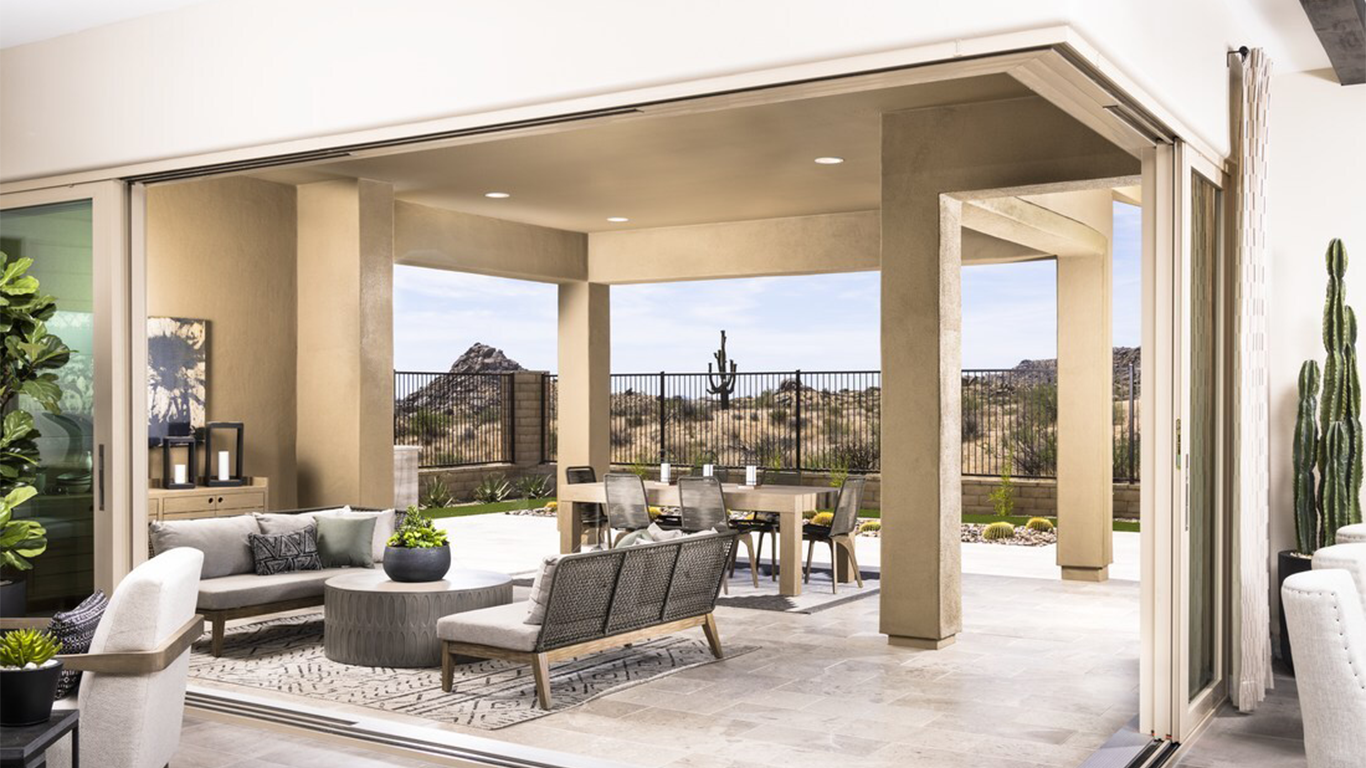18 top home design tips from the experts: real-world applications
Creating a home that truly works for daily life requires more than just following trends — it demands practical wisdom and proven strategies. This article brings together insights from industry experts who share real-world approaches to making spaces both beautiful and functional. From lighting choices to storage planning, these tips cover everything needed to design a home that reflects authentic living rather than showroom perfection.
LOCAL NEWS: Phoenix housing market outpaces national trends again in 2025
INDUSTRY INSIGHTS: Want more news like this? Get our free newsletter here
- Treat Your Builder as Teammate
- Design for Actual Life, Not Aspirations
- Plan Storage Solutions Before You Need Them
- Make Each Space Tell Your Lived Story
- Invest in Timeless Pieces That Last
- Color Sets the Mood Before Anything
- Create a Lived-In, Not Staged Home
- Prioritize Comfort and Functionality Over Aesthetics
- Transform Space with Strategic Lighting Choices
- Build for Real Life, Not Imagined
- Decorate for Peace, Not Perfection
- Fill Your Home with Meaningful Things
- Design for Movement Flow and Sightlines
- Quality Beats Size in Home Design
- Let Natural Light Lead the Way
- Build on Your Own Space Realities
- Embrace Timeless Design Over Passing Trends
- Choose One Aesthetic for Entire Home
Treat Your Builder as Teammate
The best design advice I ever received came from a contractor early in my career: “You and the builder are on the same team.” Sounds simple, but it completely changed how I approach projects. Instead of viewing construction as adversarial, I started designing with buildability in mind from day one.
I applied this to my own home renovation by involving the builder during the design phase, not after. We identified a structural beam that could stay exposed instead of being hidden, which saved $8,000 and became the focal point of our living room. That single conversation prevented change orders and created better design.
The impact has been huge professionally. My projects come in on budget 90% of the time because I’m thinking about the guy with the hammer while I’m still sketching. I even adjust my drawing notations based on feedback from trades — like when I worked on a Belize project and learned their concrete pouring methods. Now my clients trust the process more because there are fewer surprises and callbacks.
This mindset also means I spend more time on job sites than most architects. I see problems before they become expensive, and builders actually call me for input instead of just making it work. That collaborative approach has built long-term relationships that keep bringing clients back.

Design for Actual Life, Not Aspirations
The best design advice I give clients is this: design for how you actually live, not how you think you should live. Most homeowners plan spaces based on aspirational behavior — the formal dining room they’ll host dinner parties in, the home gym they’ll use daily, the pristine white kitchen that stays spotless. Then reality hits. The dining room sits empty while everyone eats at the kitchen island. The gym becomes storage. The white countertops stress them out with every coffee spill.
I advise clients to track their actual patterns for a few weeks before finalizing design decisions. Where do you naturally drop keys and bags when you enter? Where does mail pile up? Do you cook elaborate meals or reheat takeout? Are you honestly going to keep open shelving organized? Design should support reality, not fight it. The clients who end up happiest are those who embrace their actual lifestyle — mudrooms with serious storage instead of pretty entry consoles, durable quartz instead of fussy marble, kitchen layouts that prioritize daily function over entertaining they do twice a year. Good design makes your real life easier, not your imaginary life prettier.
Plan Storage Solutions Before You Need Them
The best design advice I got early on was during my ServiceMaster days doing restoration work: “Design storage solutions before you need them, not after clutter takes over.” It sounds simple, but most people wait until they’re drowning in stuff to think about where it goes.
When Stephanie and I built our forever home in 2019, I applied this religiously. We built in a hidden storage bench in the mudroom specifically for sports equipment — it turned out to be a lifesaver when I started coaching the kids’ teams. Baseball bats, gloves, fishing gear, all the chaos has a designated spot that doesn’t scream “clutter” when you walk in the door.
The real impact showed up about six months in. Our friends who built around the same time kept buying storage bins and fighting with closet organizers. We haven’t bought a single aftermarket storage solution because we planned for real life from day one. Now I push every Yingling Builders client to think through their actual daily routines–where do wet coats go, where does mail land, where do kids dump backpacks. Build those solutions into the studs, not onto your shopping list later.

Make Each Space Tell Your Lived Story
The best design advice I’ve ever received is to make sure each space tells a story you actually live in. I used to decorate by trend: neutral colors, organized in an orderly fashion, nothing out of place, and it always felt like someone pretending to be my home.
Once I began creating around meaning and not looks, everything became different. I papered my studio with old chess boards from students around the world, some pieces of art that didn’t match but meant a lot to me, and warm, layered lighting that made late-night sessions feel cozy and focused. It’s a space that was less curated and more alive.
The implications were largely emotional. I was more productive, felt more inspired, and was grounded in a room that spoke to my real journey, not someone else’s ideal.

Invest in Timeless Pieces That Last
The principle that has most influenced my design philosophy has been “invest in timeless pieces.” Trends come and go, but items with classic design, high-quality workmanship, and durable materials will always remain in style. I applied this by prioritizing key investments in my home, starting with the floors.
An antique rug is the embodiment of something timeless. It is a piece of art that has permanent value. In my study, an antique Persian rug beautifully balances the room with its geometric design and rich colors. It was complemented with a quality leather armchair and a desk in hardwood — furnishings that become more valuable over time. This gives a sense of quality and permanence. I can be sure the room won’t look dated in a few years. I feel like I am in a well-curated and collected space.

Color Sets the Mood Before Anything
The best design advice I’ve ever received about paint was simple but powerful: “Color sets the mood before anything else does.” At first, it sounded like one of those cliché design quotes you see online, but once I started experimenting with paint in my own home, I realized how true it really is. Paint isn’t just decoration — it completely changes how a space feels, how you move through it, even how you spend time in it.
When I first moved into my place, I played it safe. All white walls. It looked clean, sure, but it also felt kind of lifeless. One day a friend who’s a designer told me to stop thinking of paint as just a background and start thinking of it as an emotion. That changed everything. I began paying attention to how certain colors made me feel, not just how they looked in photos.
In my living room, I went with a warm greige — somewhere between gray and beige — with a soft, creamy undertone. It instantly made the space feel cozy and inviting without being dark or heavy. I found that I actually spent more time there, relaxing instead of always working. Then I took a bigger risk in my bedroom with a muted sage green. It felt a little bold at first, but once it dried, it completely calmed the space. It’s now my favorite room in the house — serene and grounding, like a quiet exhale.

Create a Lived-In, Not Staged Home
The best design advice I ever received was to create a house that feels lived in, not staged. In real estate, I walk through countless homes that are beautiful on the surface but lack warmth or function. A house should welcome you in every season of life, not just impress visitors. That idea shifted how I think about design, both in the homes I sell and in my own.
When I applied that advice at home, I focused on timeless materials, balanced lighting, and spaces that flow naturally. Every detail, from how furniture guides conversation to how sunlight lands in the morning, was chosen for comfort and connection. I wanted a house that supported how I live, not one that needed constant upkeep or reinvention.
The impact has been lasting. My home feels like a retreat, a place that grounds me before another busy day in real estate. It reminds me that design is not about perfection; it is about purpose. When I help clients choose houses, I encourage them to picture real life unfolding there, not a photo-ready scene. That is where lasting satisfaction begins.

Prioritize Comfort and Functionality Over Aesthetics
The best design advice I’ve received is to prioritize comfort and functionality over sleek aesthetics or trendy technology. When redesigning my home last year, I focused on creating warm lighting throughout and established a comfortable relaxation nook instead of filling spaces with visually impressive but less functional pieces. This approach transformed how my family uses our living spaces, creating areas where people naturally gather and feel at ease rather than rooms that look impressive but remain largely unused.

Transform Space with Strategic Lighting Choices
The best design advice I’ve received is that thoughtful lighting choices can transform how spacious a room feels. In my own home office, I’ve implemented this principle by using a combination of small desk lamps and flush recessed lighting while avoiding pendant fixtures that visually crowd the space. This strategic approach to lighting has significantly impacted how I experience my workspace, making a relatively small area feel much more open and functional without sacrificing the illumination needed for productivity.

Build for Real Life, Not Imagined
The best design advice I received was to build for real life, and not the imagined one. Many houses are designed to dazzle but to be very awkward to live in. I took that lesson to heart in my own house, by designing spaces based on how we actually live in them. Storage went where things were dropped naturally, the kitchen was designed around how meals are actually cooked, and choices were made for durability and comfort rather than beauty. Every choice was made with how we live day to day in mind.
The result is a house which feels right and is normal. It looks good because it works well, not vice versa. There is no clutter and no irritation, only a quiet function. That philosophy governs every project at my business, where the message is to always build homes which will age gracefully and function intuitively for the people in them.

Decorate for Peace, Not Perfection
The best design advice I’ve ever received was to decorate for peace, not perfection. I want my home to be comfortable for whoever’s visiting. More importantly, for my family, there’s nothing higher in my priorities than fostering a nurturing and warm environment. Homes are meant to be lived in; they shouldn’t be so rigid or cold that a child would feel out of place.
With that in mind, I don’t equate how expensive something is with its decorative impact. Instead, I prioritize visual appeal with function. I love warm, natural textures like wood and linens.
This overall shift in my thought process made our home calmer and easier to maintain, especially with kids running around. I suppose that’s the proof, isn’t it? Our kids have a blast within the walls of our home, and I don’t feel stressed out that they’re going to break something. Peace is our new perfection, and we love it.

Fill Your Home with Meaningful Things
The most important design advice I’ve ever received was that your home should be a storybook filled with things that matter. It comes from Nate Berkus, and it’s about how instead of just picking all the furniture from one style, you mix modern with vintage and family and travel and the like.
When my husband and I moved into our current house, I could easily have gone the Pinterest route, adding stuff to carts. But instead, I took a sort of museum approach: putting our sleek modern sofa next to my grandma’s antique pine blanket chest, a giant 1970s print of a building that I bought at a flea market in Madrid above my desk, and silver jewelry trays in every room, because I own so many silver jewelry trays.
Where did I get these silver jewelry trays, you ask? Well, I have three of them. One we bought during a road trip when we stopped in New Mexico. One we bought at a flea market. And one we inherited from the bottom of my mom’s jewelry pile.
And what’s neat is that when we have people over, literally no one comments on the furniture. Everyone comments instead on the details, the faded ceramic bowl overrun with friendship bracelets, and the mismatched photo frames slapped onto the wall running up our stairs. Bringing in old stuff that matters makes your house a conversation starter and a warm place to be. It elevates my mood every day to see in my home evidence of a messy, imperfectly layered life.
If you want to try this, the way I recommend doing it is not to try to do a whole room at once, but to start with one surface or shelf, and add one piece of old next to one piece of new. Gradually, you’ll get a look that’s not only beautiful but truly yours in a way you can’t buy.

Design for Movement Flow and Sightlines
I am a fan of HGTV because it provides me with great ideas for mixing aesthetics with living practically. The best design advice that I ever received from them was to always design for the flow of human movement and never obstruct sightlines. This tip is simple yet incredibly effective as people get frustrated easily when their natural path is blocked or their view is blocked.
I applied this tip to my West Palm Beach apartment and changed the placement of furniture in my living room. Specifically, I pushed the large seven-foot couch away from the door by 2 1/2 feet so it was no longer required to go around the end of it. The effect was immediate and tangible as it was effortless to walk through the room and the space felt significantly larger and more inviting. The living area and the adjoining balcony view remained completely unobstructed, making the whole apartment feel more optimized and less cluttered. It proves that minor changes on the level of spatial awareness make a huge difference to comfort in daily life.

Quality Beats Size in Home Design
One of the mantras I learned early in my home design career, and one that still serves me well, is, “Big doesn’t mean quality, and small doesn’t have to be cheap.” This is the core principle I put into our designs today. My goal is to provide elevated, well-built home experiences that don’t have sprawling square footage. This is advice that you can use in just about any space. Focus on making it functional and include quality fixtures and finishes, and a lack of space won’t matter.
Let Natural Light Lead the Way
Let natural light lead the way. A home can have the best layout or the newest fixtures, but if it feels dark and closed in, it loses its warmth. When my wife and I remodeled our home, we focused on opening things up: larger windows, lighter paint, and clear sight lines from room to room. It completely changed how the house feels.
Now, mornings start with sunlight streaming into the kitchen, and it sets the tone for the day. It’s amazing how much brighter spaces affect mood and energy. As someone who’s in homes every day, I notice instantly when a property has that inviting, light-filled quality. Buyers may not always know why they love it, but they feel it.
That experience reminded me that design is about how a space makes you feel. In my own home, that created a place that feels open, calm, and alive.

Build on Your Own Space Realities
Instead of recreating a Pinterest photo, build on the realities of your own space.
As a specific example: we would have loved a large ensuite bathroom, but accomplishing this meant tearing down multiple walls. Instead of trying to replicate all of those beautiful, oversized ensuites we saw on Instagram and Pinterest, we decided to lean into the coziness of our ensuite and get creative with the layout by putting the bathtub in the bedroom itself rather than in the ensuite.

Embrace Timeless Design Over Passing Trends
In real estate, I’ve seen so many styles come and go. What feels new and exciting today can look dated just a few years later. Homes with clean lines, simple color palettes, and natural textures always seem to stand the test of time. They feel comfortable and inviting, no matter what’s trending.
At home, I follow that same approach. I like spaces that are easy to live in and easy to update. Neutral tones make it simple to change up furniture or artwork without starting from scratch. I’ve found that when the foundation of a space is calm and cohesive, it brings a sense of peace that lasts.
That perspective carries into my work every day. When I walk through a home with a client, I often point out the design choices that will still look good years down the road. A timeless home doesn’t need constant updates or big renovations to stay appealing. It’s built on quality, simplicity, and comfort.
Design trends will always shift, but a home that feels genuine never goes out of style. That kind of design not only holds value but also creates a sense of belonging that people connect with instantly.

Choose One Aesthetic for Entire Home
I think the best design advice I have received is to pick one overarching aesthetic for my home and then think of how each room can contribute to it. This ultimately comes down to taste, but I do prefer to have my home feel like a single harmonious space, with design elements that are consistent from room to room. So, coming up with a “theme” for the entire home, and then exploring that aesthetic in every room, has been both a good way to have that harmonious aesthetic while still having the freedom to decorate each room individually.







